Exploring the Quantum Money
In traditional currency systems, identification relies on serial numbers. Each currency note has embedded strips, holograms, special inks, or microprinting to safeguard its integrity. Classical information can, of course, be copied. More specifically, if we have a currency note, a determined counterfeiter guy could try to build an identical copy. But what happens when we encode information using Quantum States? Can this encoding prevent the creation of exact copies?
The answer lies in the “no-cloning theorem” that states:
“Given a quantum state, there is no way to produce copies of that state.”
This fundamental principle of Quantum Mechanics that tells us that copying quantum states perfectly is impossible and has profound implications in Quantum Computing and across various disciplines.
Quantum Money was coined in 1983 when Stephen Wiesner introduced it as a precursor to the BB-84 protocol for secure communication. The challenge was to design a foolproof system that prevents counterfeit currency!
Using quantum concepts like the no-cloning theorem and complementarity offers a way to create currency notes that are hard to copy and identify a forged copy with certainty. Imagine currency bills containing trapped photons secretly prepared in one of four BB-84 states. At the bank, there is a record of all polarizations and the corresponding serial number. On the quantum bank note, the serial number is printed, but the polarizations are kept secret. The bank can always verify the polarization by measuring the polarization of each photon without introducing any disturbance.
For counterfeiters, the serial number might be known, but copying the polarization states is a real challenge. To replicate photon polarization states, one must determine the bases for each photon — similar to the dilemma faced by Eve in the BB-84 Protocol. If they chose the wrong basis, it will change the polarization of the photon in the trap. The counterfeit or forged banknote created will be with this wrong polarization. The fact that quantum state cannot be copied, this challenge is the core of the system’s strong security.
